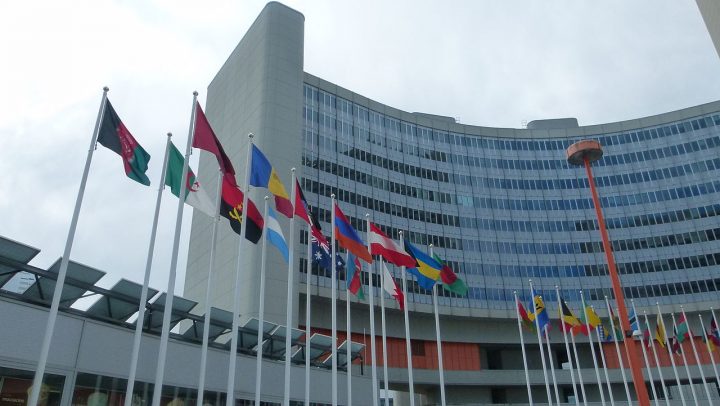Another cycle of conferences started this week in Vienna to culminate in a conference to review the nuclear Non-Proliferation Treaty (NPT) in 2020. States Parties and civil-society organisations have exchanged views in the general debate and in a number of side events.
Many nations with nuclear weapons, and those in security agreements with them, have sought to make this all about North Korea’s nuclear programme in a justification of their continued refusal to disarm.
Reaching Critical Will, the disarmament branch of the Women’s International League for Peace and Freedom, pushed attention back to the nuclear States Parties present in Vienna and held a mirror up to their NPT violations in their presentation in the general debate.
Statement by the Women’s International League for Peace and Freedom to the 2017 NPT Preparatory Committee, Vienna, 3 May 2017
Delivered by Ray Acheson, Director of WILPF’s Reaching Critical Will programme
All of the nuclear-armed states—including those that are states parties to the NPT—are investing in the expansion, development, or so-called modernisation of their nuclear arsenals. These programmes are not just about “increasing the safety and security” of nuclear weapon systems, which is what the nuclear-armed states claim. The “upgrades” in many cases provide new capabilities to the weapon systems. They also extend the lives of these weapon systems beyond the middle of this century, ensuring that the arms race will continue indefinitely.
China is transitioning from liquid-fueled slow-launching missiles to solid-fuel, quicker-launching roadmobile missiles, to make the force more “useable”. Recently China has also sped up the modernisation of its sea-based strategic force, replacing its first generation ballistic nuclear missile-carrying submarines.[1]
France has replaced its sea-launched ballistic missiles for its current class of submarines[2], and is also planning to develop new missiles for a new class of submarines[3]. It has carried out studies for a next generation air-launched cruise missile[4]. Half of its nuclear bomber force has been upgraded so far.
Russia is modernising its main silo- and road-mobile ICBM[5]. It is also developing a new silo-based ICBM[6], and is upgrading its ballistic missile submarine force[7]. It’s also working on its nuclear attack submarines and nuclear-capable cruise missiles[8], as well as its bombers[9].
The UK parliament voted in favour in July 2016 of renewing its Trident nuclear weapon system. This means that the UK’s Vanguard-class submarines will be replaced with the “Dreadnought”-class of submarines[10]. In 2019, the UK will also make a decision about the design of a new warhead[11].
The United States is developing a new class of ballistic missile submarines, a new long-range bomber with nuclear capability, a new air-launched cruise missile, a next-generation land-based ICBM, and a new nuclear-capable tactical fighter aircraft. It will also include work on warheads and nuclear command and control facilities[12].
More examples, including from non-NPT states parties, can be found in WILPF’s updated study Assuring destruction forever[13].
The only way to prevent states from modernising their nuclear weapons is to prohibit and eliminate these weapons. In the meantime, NPT states parties are already legally obligated to end the nuclear arms race and achieve nuclear disarmament.
This NPT outcome should reflect the serious concern expressed by many states parties about modernisation and development of nuclear weapon systems, and call for the cessation of such programmes, which violate article VI of the NPT and entrench double standards.
[1] “Annual Report to Congress – Military and Security Developments Involving the People’s Republic of China 2014,” Office of the Secretary of Defense, 24 April 2014, http://www.defense.gov/pubs/2014_DoD_China_Report.pdf.
[2] Julien Bonnet, “Tir d’essai réussi pour le missile nucléaire M51,” L’UsineNouvelle, 1 July 2016; “Successful M51 Ballistic Missile
[3] Speech by François Hollande, Visit to the Strategic Air Forces, 25 February 2015,
[4] JeanYves Le Drian, Defense Minister, Closing Remarks – Symposium for 50 Years of Deterrence, 20 November 2014,
[5] Hans M. Kristensen and Robert S. Norris, “Russian nuclear forces, 2017,” The Bulletin of Atomic Scientists, Vol. 73, No. 2, pp. 119–120; Pavel Podvig, “Flight tests of Barguzin rail-mobile ICBM are said to begin in 2019,” Russian strategic nuclear forces, 19 January 2017.
[6] Hans M. Kristensen and Robert S. Norris, op. cit., p. 120.
[7] Hans M. Kristensen and Robert S. Norris, op. cit., p. 121.
[8] Hans M. Kristensen and Robert S. Norris, op. cit., p. 123.
[9] Hans M. Kristensen and Robert S. Norris, op. cit., p. 122.
[10] John Ainslie, The Trident shambles, Scottish CND, March 2016, http://www.banthebomb.org/images/stories/pdfs/shambles.pdf .
[11] National Security Strategy and Strategic Defence and Security Review 2015, op. cit., p. 35.
[12] Kristensen and Norris, op. cit., p. 49.
[13] See http://reachingcriticalwill.org/images/documents/Publications/modernization/assuring-destruction-forever-2017.pdf.










